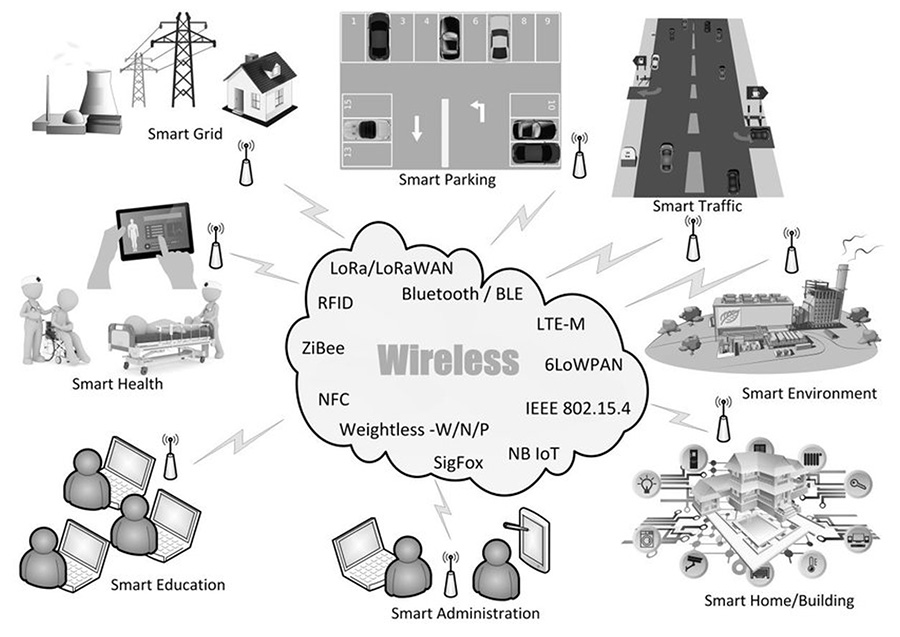The relentless march of technology continues to impact virtually every facet of human life—in 2013, only 13% of American’s owned a smartphone; today that number has reached 91%[i]; 58% of people in the US turn to online sources for their news[ii]; automated self-service checkout terminals now account for 55% of all grocery store sales[iii]—and the list goes on.
What emerges is the picture of a hyperconnected, digitally reliant society. And that’s not altogether a bad thing. The technologies that enable us to bypass the express lane while ordering dinner delivery and checking our newsfeeds have been nothing short of life changing, providing more freedom and convenience and connecting us like never before.
So, it is only natural that the steady evolution from the automated workplace and smart homes should lead to the smart city. And the timing could not be better. By 2050, the global population is projected to increase to around 9.8 billion, 6.7 billion (68%) of whom will be living in urban settings.[iv] The projected influx into cities will present significant challenges in managing public infrastructure, services, public safety, economic opportunity, the environment and much more.
To meet these challenges, smart cities have continued to evolve; meaning, the underlying network infrastructure must evolve as well. In this blog, we take a look at how smart city designs are changing and what that means for municipal planners and their technology partners.
What Makes a City Smart is Changing
In the early 2000s, the smart city concept focused largely on the use of IoT technology, primarily sensors and cameras, to collect and analyze data and improve service delivery and decision making. Early applications focused on improving public transportation systems, enhancing public safety with gunshot detection, making better use of city resources via utility metering and monitoring key environmental factors like pollution and water quality.
Since then, advances in cloud computing, big data analysis and AI/ML (Artificial Intelligence/Machine Learning)—having been implemented and vetted in the commercial sector—are now finding applications in urban and suburban communities. Some of these advanced technologies and capabilities include:
Edge computing processes data in real-time, close to the source, to analyze real-time traffic data and adjust the timing of the lights to optimize traffic flow.
Natural Language Processing powers applications like online chatbots, virtual assistants, voice-activated devices, and translation tools.
Computer vision trains machines to analyze visual data from sensors/lenses, enabling the recognition, classification, and tracking of moving objects.
“The smart cities concept has become more holistic…moving beyond the implementation of technology to encompass meanizgful community engagement, fluid communication capabilities, eliminating waste, sustainable environmental practices, the smarter use of resources and a better quality of life.”
Smart Cities Dive, Nov. 9, 2021
Neural networks are a type of AI-ML algorithm that are commonly used for tasks such as image and speech recognition or decision-making and autonomous vehicle guidance and safety.
Deep learning uses multi-layered neural networks that can be trained on large datasets identify patterns and predict changes in demand or use of transit, infrastructure, energy, and more.
The Impact on Network Infrastructure
Regardless of the specific applications deployed, the presence of a seamless, highly adaptable, low-latency infrastructure is absolutely necessary. It is “the backbone that enables seamless connectivity and efficient operations across various sectors. This component encompasses a range of technological solutions that work together to enhance urban living.”[v]
As the focus of smart city development moves beyond IoT connectivity and toward greater use of artificial Intelligence the impact on the network infrastructure—its components, connectivity and architectures—is significant.
For example, applications like automated vehicle guidance will involve a massive network of connected roadside sensors and the aggregation of billions of data points representing varying traffic types, priorities and latency-sensitivities. This one application has multiple implications regarding the network’s capabilities and design.
As peak data loads in these scenarios may be highly random, the underlying network infrastructure must be able to adapt intuitively. For example, employing SD-WAN (Software Defined-Wide Area Network) to allocate additional bandwidth when and where it’s most required and prioritize service-level agreements (SLAs) to meet individual application performance demands.
At the same time, the computer resources and latency requirements needed to support the application suggest an edge-based architecture equipped with remote “micro data centers” that can handle the ultra-low latency, high-capacity processing requirements.
This is just one example of how emerging smart city AI applications will push municipal network managers and their utility network partners to adapt their infrastructure. Success will be determined in large measure by the network’s degree of design flexibility and scalability, as well as ease of deployment and management.
At the same time, smart city networks will need to support any number of power and wireless interface protocols, now and in the future. On the wireless side, the number of options is quickly growing. In addition to entrenched technologies like 4G/LTE, 5G, WiFi, Bluetooth and RFID, networks will need to support Private LTE, CBRS, LoRa/LoRaWAN, ZiBee, BLE, ATSC 3.0 and more.
In many cases, the power requirements (as well as data bandwidth) for IoT devices, smart lighting and powered components can be safely delivered using POE, POE+ or POE++. Network components and systems requiring more than power, currently over 60W per device, will need a separate power feed. The takeaway? The best smart city networks will run on infrastructures that are vendor-neutral and technology-agnostic.

Choosing the Right Infrastructure Partner
As citizens’ expectations grow and urban populations continue to expand, the pace of progress and need for innovation isn’t likely to let up. There is no shortage of new more capable smart city applications being developed. But they will only be as effective as the infrastructure on which they operate; this is true now, and, in the future—and cannot be overemphasized.
Therefore, the planning, implementation and operation of any smart city technologies begins by partnering with the right infrastructure partner. At Trilogy Next-Gen Networks, we’re empowering and equipping cities across the country, preparing for a future in which they will thrive.
As a leading designer and manager of highly reliable and secure networks, Trilogy NextGen provides customized connectivity solutions to education institutions, smart cities, and industries by utilizing a variety of spectrum (CBRS, unlicensed, and broadcast) and technologies (LTE/5G, Wi-Fi, ATSC 3.0).
With our expertise in networks, IT, and cloud, we enable municipal network managers and their technology partners to create the high-reliability and adaptable network infrastructure to support the wide range of smart city applications, now and in the future. Working closely with experienced providers of physical security systems, transportation, resource management solutions and more, we leverage the specific technologies that enable you to meet the changing needs of today’s smart city environment.
For more information on how Trilogy Broadband is helping municipal network managers and their partners plan, deploy and manage their smart city infrastructures. Click here to set up a meeting or demo.
[i] How Many Americans Have Smartphones (2013–2023); Oberlo, report; Jun 7, 2023
[ii] Half of Americans believe news organizations deliberately mislead them; Fortune, article; Feb 15, 2023
[iii] Self-checkout is now the dominant checkout format in grocery; Grocery Dive, article; April 26, 2023
[iv] “Urbanization” by Hannah Ritchie and Max Roser; OurWorldInData.org; 2018
[v] Exploring the Evolution and Future of Smart Cities; DenisMarie Uche Akabogu, LinkedIn post; Aug. 26, 2023
